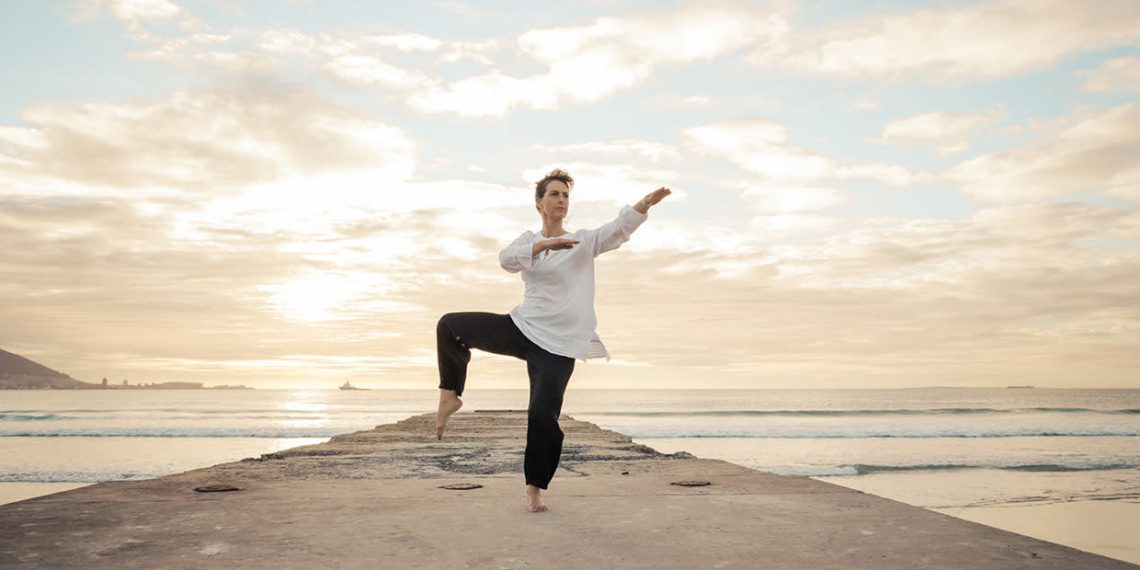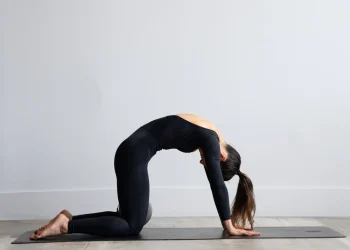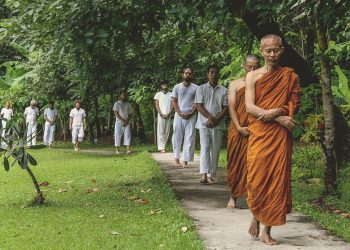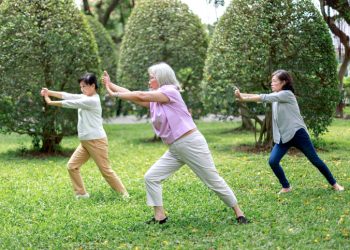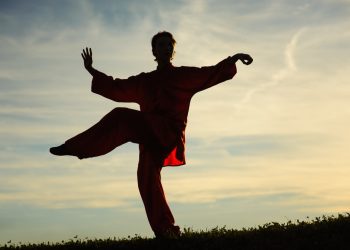Tai Chi walking form, often called “Tai Chi walking meditation” or “cloud walking,” represents one of the most fundamental yet profound practices within the Tai Chi tradition. While it may appear deceptively simple to observers, this deliberate, mindful way of moving embodies the essential principles that underpin all Tai Chi forms. Understanding and mastering proper form in Tai Chi walking provides practitioners with a solid foundation for more advanced practices while delivering substantial health benefits on its own.
The Essence of Tai Chi Walking
Tai Chi walking differs fundamentally from ordinary walking. Rather than moving unconsciously from point A to point B, Tai Chi walking transforms each step into a meditation in motion. This practice cultivates awareness of weight distribution, body alignment, breath coordination, and the subtle flow of internal energy, or “qi,” through the body. The walking form serves as a bridge between static standing meditation and the flowing movements of traditional Tai Chi forms, making it an invaluable tool for beginners and advanced practitioners alike.
Fundamental Body Alignment Principles
Before taking your first Tai Chi step, establishing proper postural alignment is crucial. These alignment principles remain constant throughout the practice, forming the structural foundation that allows energy to flow freely through the body.
The head position sets the tone for the entire spine. Imagine a string gently pulling the crown of your head toward the sky, creating a sensation of the head floating upward. This mental image helps elongate the neck without creating tension. The chin should remain slightly tucked, not jutting forward, which helps align the cervical spine properly. Your gaze should be soft and directed naturally forward at approximately eye level, neither staring intently at a fixed point nor letting the eyes wander aimlessly.
The spine maintains its natural curves while elongating vertically. Think of stacking each vertebra one atop the other like building blocks, creating space between each segment. The chest remains relaxed and slightly hollow rather than puffed out, which allows the upper back to maintain its natural width. This “containing the chest and rounding the back” principle prevents the rigidity that blocks energy flow while maintaining structural integrity.
The shoulders and arms deserve special attention as they often harbor unconscious tension. Shoulders should drop naturally away from the ears, with the shoulder blades settling gently down the back. The elbows remain slightly bent and pointed downward, never locked straight. Arms hang loosely at the sides, creating gentle curves from shoulder to fingertip. Imagine your armpits holding small, soft balls that should neither be squeezed nor dropped—this mental image helps maintain the appropriate arm position.
The pelvis and hips form the body’s center of gravity in Tai Chi. The pelvis should be in a neutral position, neither tilted too far forward (creating a swayed back) nor tucked under excessively. Think of the pelvis as a bowl of water that you’re carrying without spilling a drop. The hips should feel loose and alive, ready to facilitate the weight shifts that characterize Tai Chi walking. The kua, the crease where the legs meet the torso, should feel open and mobile rather than locked or compressed.
The Mechanics of Tai Chi Walking
The actual walking form follows a precise sequence that emphasizes complete weight transfer, rooted stance, and continuous flow. Each component deserves careful attention and practice.
Begin in a neutral standing position with feet parallel and shoulder-width apart. This starting stance, called Wu Chi, allows you to center yourself and establish proper alignment before moving. Take a few moments to scan your body from head to toe, releasing any obvious tension and connecting with your breath.
The weight shift initiates all movement in Tai Chi walking. Before lifting the front foot, gradually transfer your entire weight onto the back leg. This shift should feel smooth and complete—imagine your weight sinking down through the standing leg into the ground like roots growing from a tree. The standing leg remains slightly bent at the knee, never locked, which helps maintain stability and allows the hip to engage properly. Only when your weight has fully transferred and you feel solidly rooted on one leg should you proceed to the next phase.
The foot lift occurs once the weight has completely shifted. The empty foot (now carrying zero weight) peels slowly off the ground, beginning with the heel. The foot lifts only as high as necessary—typically just a few inches—to clear the ground and move forward. Throughout this phase, the ankle remains relaxed, allowing the foot to hang naturally rather than being held rigidly. The knee of the lifted leg stays pointed in the direction of travel, maintaining proper alignment of the leg structure.
Foot placement requires precision and awareness. As the foot moves forward, it travels in a straight line rather than swinging out to the side. The heel touches down first, making initial contact with the ground. The foot lands softly and deliberately, as if testing thin ice, rather than stamping or slapping down. Upon heel contact, the toes remain lifted slightly off the ground—the foot has landed but not yet accepted weight.
The weight transfer to the forward leg happens gradually and continuously. As the heel of the front foot makes contact, begin slowly rolling the foot down until the entire sole connects with the ground. Simultaneously, start shifting weight forward onto the front leg. This transfer should feel smooth and unrushed, taking several seconds to complete. The back foot remains flat on the ground as long as possible, only rising onto the toes as the weight shift nears completion. Finally, the back foot becomes completely empty and begins to peel off the ground, initiating the next step cycle.
Maintaining Proper Form Throughout Practice
Consistency in form requires sustained attention to several key principles throughout your practice session.
The continuous flow of movement represents one of Tai Chi’s hallmarks. Each phase of the walking cycle should blend seamlessly into the next without stopping, speeding up, or slowing down erratically. Imagine moving through water or thick honey—your movements should have this quality of smooth resistance, maintaining constant speed throughout. Even the transitions between weight shifts should be fluid, without any jerky or abrupt movements.
The principle of “separating empty and full” means clearly distinguishing between the weighted leg (full) and the unweighted leg (empty). At any given moment during practice, one leg should be clearly supporting your weight while the other remains relatively free. This separation allows for stable, controlled movement and prevents the awkward double-weighted stance that occurs when weight remains equally distributed between both legs. Double-weighting creates instability and blocks the smooth flow of energy through the body.
Breathing coordination enhances the meditative quality of Tai Chi walking. While various breathing patterns exist, a common approach involves inhaling as you lift the empty foot and begin moving it forward, then exhaling as you place the foot down and transfer weight forward. The breath should be natural, deep, and coordinated with movement rather than forced or held. Some practitioners prefer to take multiple breaths per step, allowing the breath to remain natural while the movements slow down. Find the rhythm that allows both your breathing and movement to remain relaxed and unforced.
Mental focus prevents the practice from becoming merely physical exercise. Throughout your walking, maintain awareness of your body position, weight distribution, and the subtle sensations of movement. Notice the feeling of your foot connecting with the ground, the shifting of weight through your legs and hips, the gentle adjustments your body makes to maintain balance. When your mind wanders to daily concerns or to-do lists—and it will—gently bring your attention back to the physical sensations of walking without judgment or frustration.
Common Form Mistakes and Corrections
Even experienced practitioners occasionally develop habits that compromise their form. Recognizing these common issues helps you maintain proper practice.
Leaning the torso forward, backward, or to the sides disrupts the vertical alignment that allows energy to flow freely. If you notice yourself leaning, return to the image of the string pulling your head upward while your weight sinks downward through your legs. The torso should remain upright throughout the weight transfer, moving forward only because the legs carry it, not because you’re falling forward from the waist.
Tension in the shoulders, arms, or hands often creeps in during practice, especially when concentrating hard on other aspects of form. Periodically scan these areas during walking and consciously release any gripping or holding you discover. The hands should be soft and natural, not clenched or rigidly spread. Some practitioners find it helpful to occasionally shake out their arms between walking cycles to release accumulated tension.
Rushing through the movements undermines the meditative quality and prevents you from developing sensitivity to subtle body mechanics. If you find yourself speeding up, consciously slow down your practice. It’s better to take fewer, slower steps with full awareness than to complete many rapid steps while on autopilot. Some practitioners find it helpful to count slowly during each phase of the step to maintain a consistent, deliberate pace.
Holding the breath or breathing shallowly often occurs when practitioners focus intensely on form. Remember that breathing should remain natural and continuous throughout practice. If you notice you’ve been holding your breath, pause briefly in your stance, take a few natural breaths, and then resume walking with renewed attention to maintaining steady breathing.
Progression and Practice Recommendations
Building a solid Tai Chi walking practice requires patience and consistent effort. Begin with just five to ten minutes of practice daily, focusing on quality over quantity. As your form improves and your body adapts, gradually extend your practice time. Some dedicated practitioners eventually enjoy walking meditation sessions of thirty minutes or longer.
Initially, practice in a straight line, moving forward for several steps, then carefully turning around to walk back in the opposite direction. As your confidence grows, you can practice walking in circles, figure-eights, or simply throughout a room, allowing the walking to become more spontaneous while maintaining proper form. Some practitioners enjoy walking outdoors in nature, which adds the dimension of uneven terrain and natural beauty to the practice, though this should only be attempted after mastering the basics on flat, level surfaces.
Consider working with a qualified Tai Chi instructor who can observe your form and provide personalized corrections. Video recording yourself can also reveal form issues that you can’t feel from inside your body. Watching yourself walk helps identify asymmetries, alignment problems, and tension patterns that you might otherwise miss.
The Deeper Journey
Tai Chi walking form represents far more than a physical exercise. With consistent practice, it becomes a moving meditation that cultivates mindfulness, improves balance and coordination, reduces stress, and promotes the free flow of energy throughout the body. The principles learned through walking practice—proper alignment, smooth weight transfer, continuous flow, and integrated mind-body awareness—translate directly into more complex Tai Chi forms and even into daily life activities.
As you develop your practice, you’ll likely discover that Tai Chi walking offers different lessons and insights over time. What initially feels mechanical eventually becomes natural and effortless. The practice that once required intense concentration begins to feel more like a meditation in which body, breath, and mind unite in harmonious movement. This transformation doesn’t happen overnight, but through patient, consistent practice, Tai Chi walking becomes not just something you do, but a way of moving through the world with grace, balance, and awareness.

